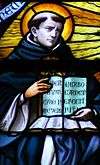Milo (bishop of Trier)
| Milo Archbishop of Trier | |
|---|---|
| Church | Catholic |
| Province | Austrasia |
| Diocese |
Trier, Rhineland-Palatinate, Austrasia (today Germany) Reims, Rhineland-Palatinate, Austrasia (today France) |
| Appointed | 722 |
| In office | 722 |
| Quashed | 744 |
| Predecessor | St. Leudwinus |
| Successor | Abel |
| Opposed to | St. Boniface |
| Orders | |
| Ordination | Benedictine |
| Personal details | |
| Birth name | Milo of Trier |
| Born | Trier, Rhineland-Palatinate, Austrasia (today Germany) |
| Died | Meulenwald, Rhineland-Palatinate, Austrasia (today Germany) |
| Buried | Meulenwald, Rhineland-Palatinate, Austrasia (today Germany) |
| Nationality | Frankish |
| Denomination | Chalcedonian Christianity |
| Parents | St. Leudwinus and Willigard of Bavaria |
Milo of Trier (d. 762 or 763) was the son of St. Leudwinus and was his successor as Archbishop of Trier and Archbishop of Reims.[1][2] His great-uncle St. Basinus had preceded his father as Trier.[1] He is the great-grandson of Saint Sigrada and Saint Leodegarius is his great uncle.
Early life
Milo was the son of the Leudwinus of Trier and Willigard of Bavaria.[1][2] He was born a nobleman and later styled Count of Trier.[2]
His brother was Wido (Gui), Count of Hornbach.[1] Chrotrude, Duchess of Austrasia (Rotrude), was apparently his sister.[2]
He received a monastic education as was the custom for Medieval noblemen and Milo became an ordained Benedictine monk.[3] Prior to his ecclesiastical career, Milo also had a military career, something he had in common with his brother-in-law Charles Martel.[3]
Archbishop of Trier
As the scion of one of the most powerful Frankish clans in Austrasia, Milo's future seemed secure.[3] He succeeded his father as Archbishop of Trier become the third generation of his family to hold this position.[3]
Bishop of Reims
When Charles Martel drove Saint Rigobert from Reims, Milo was appointed his successor.[2][3]
As bishop, Milo became a controversial figure in the history of the Church.[2][3] His avarice and fondness of earthly pleasures soon placed him in opposition with the church.[2][3]
Milo did not lead a spiritual life and flagrantly ignored the Rules of Saint Benedict that governed his colleagues.[2][3] He habitually used church property for his personal and political purposes, usually to indulge his illegitimate sons.[2][3] He accumulated much of the riches of his dioceses and developed a reputation for corruption.[2]
Accounts of Milo's time as bishop are collected in the Gesta Treverorum.
Deposition
Politically, Milo was a formidable opponent of St. Boniface's reforms of the church in the eastern Frankish Empire.[2][3] However when Milo's own behavior invited the criticism of Pope Zachary, Boniface seized the opportunity and began a campaign to have Milo replaced.[2]
In March 744, Boniface successfully pursued the Synod of Soissons to remove Milo as Archbishop of Trier.[2] By that time, Milo's behavior had become so repugnant even his formidable political connections could not save him.[2] Though he put up a lengthy resistance, Milo was deposed as bishop and replaced by Abel.
Death
Milo was killed by a wild boar in a hunting accident in Meulenwald near Trier sometime between 753 and 758.[2][3][4]
Since the 4th century, it had been a tradition to bury the bishops of Trier in the crypt at St. Maximin's Abbey in Trier.[4][5] However, due to his controversial life, Milo was not given this honor and was instead buried near the scene of the accident where a memorial, The Cross of Milo, was erected.[3][4]
See also
Notes
- 1 2 3 4 Junges, Reinhold. "Mettlach Parish Church: St. Lutwinus Biography (Pfarrkirche St. Lutwinus Mettlach)". The New Church Leader (Neuer Kirchenführer erschienen). Verlag Schnell und Steiner Regensburg. Retrieved June 27, 2012.
- 1 2 3 4 5 6 7 8 9 10 11 12 13 14 15 Hahn, Heinrich (1885). Milo: General German Biography (Milo In: Allgemeine Deutsche Biographie) (ADB). Leipzig: Duncker & Humblot. p. 758.
- 1 2 3 4 5 6 7 8 9 10 11 12 Zenz, Emil (2004). The Lay Bishop Milo (Der Laienbischof Milo). Trier-Ehrang: Jahrbuch Ehranger Heimat. pp. 92–94.
- 1 2 3 Schuhn, Werner (1987). The Cross of Milo: History, legend and tradition is a venerable cultural landmark(Das Milokreuz. Geschichte, Sage und Brauch um ein ehrwürdiges Kulturdenkmal). Trier (Trier): Jahrbuch Landkreis Trier-Saarburg. pp. 292–297. ISSN 0942-0835.
- ↑ Sanderson, Warren (December 1965). "The Early Mediaeval Crypts of Saint Maximin at Trier". The Journal of the Society of Architectural Historians. 24 (4): 304. doi:10.2307/988315.
| Catholic Church titles | ||
|---|---|---|
| Preceded by St. Leudwinus |
Archibishop of Trier c. 722–762/3? |
Succeeded by Wiomad |
| Catholic Church titles | ||
|---|---|---|
| Preceded by Rigobert |
Bishop of Reims c. 722–762/3? |
Succeeded by Abel |

